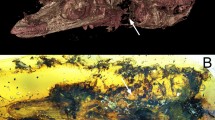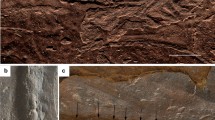Abstract
Two fleas have been collected in association with abundant remains of fish, plants, phyllopod Crustacea (Conchostraca, Anostraca and Cladocera) and other insects in a Lower Cretaceous siltstone at Koonwarra, southern Gippsland, Australia. The insect fauna consists mainly of the aquatic immature stages of Ephemeroptera (mayflies), Diptera (midges), Coleoptera (beetles), Plecoptera (stoneflies) and Odonata (dragonflies and damselflies). The aquatic larvae of the scorpionfly family Nannochoristidae (Mecoptera) are also preserved. There is also a small adventitious fauna of adult insects, including the fleas, the immature stages of which are not aquatic. The only known remains of warm-blooded vertebrates are feathers1.
This is a preview of subscription content, access via your institution
Access options
Subscribe to this journal
Receive 51 print issues and online access
$199.00 per year
only $3.90 per issue
Buy this article
- Purchase on Springer Link
- Instant access to full article PDF
Prices may be subject to local taxes which are calculated during checkout
Similar content being viewed by others
References
Talent, J. A., Duncan, P. M., and Handby, P. L., Emu, 66, 81 (1966).
Author information
Authors and Affiliations
Rights and permissions
About this article
Cite this article
RIEK, E. Lower Cretaceous Fleas. Nature 227, 746–747 (1970). https://doi.org/10.1038/227746a0
Received:
Revised:
Issue Date:
DOI: https://doi.org/10.1038/227746a0
This article is cited by
-
The first flea with fully distended abdomen from the Early Cretaceous of China
BMC Evolutionary Biology (2014)
-
Mesozoic giant fleas from northeastern China (Siphonaptera): Taxonomy and implications for palaeodiversity
Chinese Science Bulletin (2013)
-
Diverse transitional giant fleas from the Mesozoic era of China
Nature (2012)
-
Die Cytogenetik der Fl�he (Aphaniptera)
Chromosoma (1971)
Comments
By submitting a comment you agree to abide by our Terms and Community Guidelines. If you find something abusive or that does not comply with our terms or guidelines please flag it as inappropriate.



